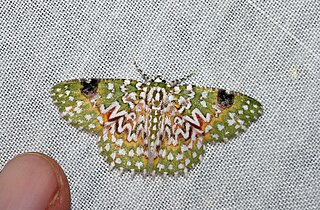Garudinia is a genus of moths in the subfamily Arctiinae first described by Moore in 1882.

Arsacia is a monotypic moth genus of the family Noctuidae. Its only species is Arsacia rectalis. Both the genus and species were described by Francis Walker, the genus in 1866 and the species in 1863. It is found from the Indo-Australian tropics of India, Sri Lanka to Queensland and the Solomon Islands.

Yepcalphis is a monotypic moth genus of the family Noctuidae erected by Nye in 1975. Its only species, Yepcalphis dilectissima, was first described by Francis Walker in 1858. It is found in Sri Lanka, the Oriental tropics, the Philippines, Sulawesi and the Sula Islands.

Eudocima materna, the dot-underwing moth, is a moth of the family Erebidae found in widespread parts of the world, mainly in tropical Asia extending to New Guinea and Australia as well as in Africa. Reports from the United States, Canada and the French Antilles are now considered to be Eudocima apta. The species can be differentiated from other Eudocima moths by the presence of small central black dot in each hindwing. The species was first described by Carl Linnaeus in his 1767 12th edition of Systema Naturae.

Eucyclodes gavissima, the Oriental orange banded green geometer moth, is a species of moth of the family Geometridae described by Francis Walker in 1861. It is found in the Indian subregion, Sri Lanka, Bhutan, western China, Taiwan, Sumatra and Borneo.
Amyna natalis, the ilima moth, is a moth of the family Noctuidae. It was first described by Francis Walker in 1858. It is widespread from tropical Asia into northern Australia. It is an introduced species in Hawaii, where it is found on Oahu.

Ramadasa pavo is a moth of the family Noctuidae first described by Francis Walker in 1856. It is found in south-east Asia. including Sumatra, Borneo, Sabah, Sulawesi, Thailand, Sri Lanka, India and China.

Herpetogramma aeglealis, the serpentine webworm moth, is a species of moth of the family Crambidae. It was first described by Francis Walker in 1859 and is found in eastern North America.

Scirpophaga incertulas, the yellow stem borer or rice yellow stem borer, is a species of moth of the family Crambidae. It was described by Francis Walker in 1863. It is found in Afghanistan, Nepal, north-eastern India, Sri Lanka, Bangladesh, Myanmar, Vietnam, Thailand, Malaysia, Singapore, Sumatra, Java, Borneo, Sumba, Sulawesi, the Philippines, Taiwan, China and Japan.

Eupithecia costalis is a moth in the family Geometridae first described by Francis Walker in 1863. It is widespread in the tropical and subtropical lowland regions of east and south-east Asia, from Taiwan to India, Sri Lanka Borneo, Borneo, to Hong Kong.
Ziridava xylinaria, the indistinct carpet, is a moth in the family Geometridae. The species was first described by Francis Walker in 1863. It is found in Sri Lanka, India, Hong Kong and on Peninsular Malaysia, Borneo, Java and possibly the Philippines and Sulawesi.
Asura floccosa is a moth of the family Erebidae. It is found in India and Sri Lanka.
Garudinia macrolatana is a moth of the family Erebidae. It is found on Borneo. The habitat consists of lowland forests.
Calamotropha delatalis, is a moth in the family Crambidae. It was described by Francis Walker in 1863. It is found in Sri Lanka and Australia, where it has been recorded from Queensland, New South Wales and Victoria.
Surattha invectalis is a moth in the family Crambidae. It was described by Francis Walker in 1863. It is found in Sri Lanka, India, Java, Indonesia, Myanmar, and Kenya.
Rupela tinctella is a moth in the family Crambidae. It was described by Francis Walker in 1863. It is found in Florida, Georgia, Louisiana, Mississippi, North Carolina, South Carolina, Texas, Mexico, Cuba, the Guianas, Trinidad, Brazil (Paraná), Paraguay and northern Argentina.
Scirpophaga excerptalis, the white top borer or sugarcane top borer, is a moth in the family Crambidae. It was described by Francis Walker in 1863. It is found in China, Taiwan, Japan, Pakistan, India, Nepal, Bangladesh, Thailand, Vietnam, Singapore, western Malaysia, Java, Sumba Island, Timor, Buru, Adonara Island, Ambon Island, the Philippines, New Guinea, New Hannover, New Britain, New Ireland, Australia and the Solomon Islands.
Scirpophaga occidentella is a moth in the family Crambidae. It was described by Francis Walker in 1863. It is found in Angola, the Democratic Republic of the Congo, Ivory Coast, Madagascar, Malawi, Mozambique, Nigeria, Senegal, Sierra Leone, South Africa and Tanzania.
Scirpophaga xanthogastrella is a moth in the family Crambidae. It was described by Francis Walker in 1863. It is found in Taiwan, India, Nepal, Sri Lanka and the Philippines.
Auzata semipavonaria is a moth in the family Drepanidae. It was described by Francis Walker in 1863. It is found in northern India.









